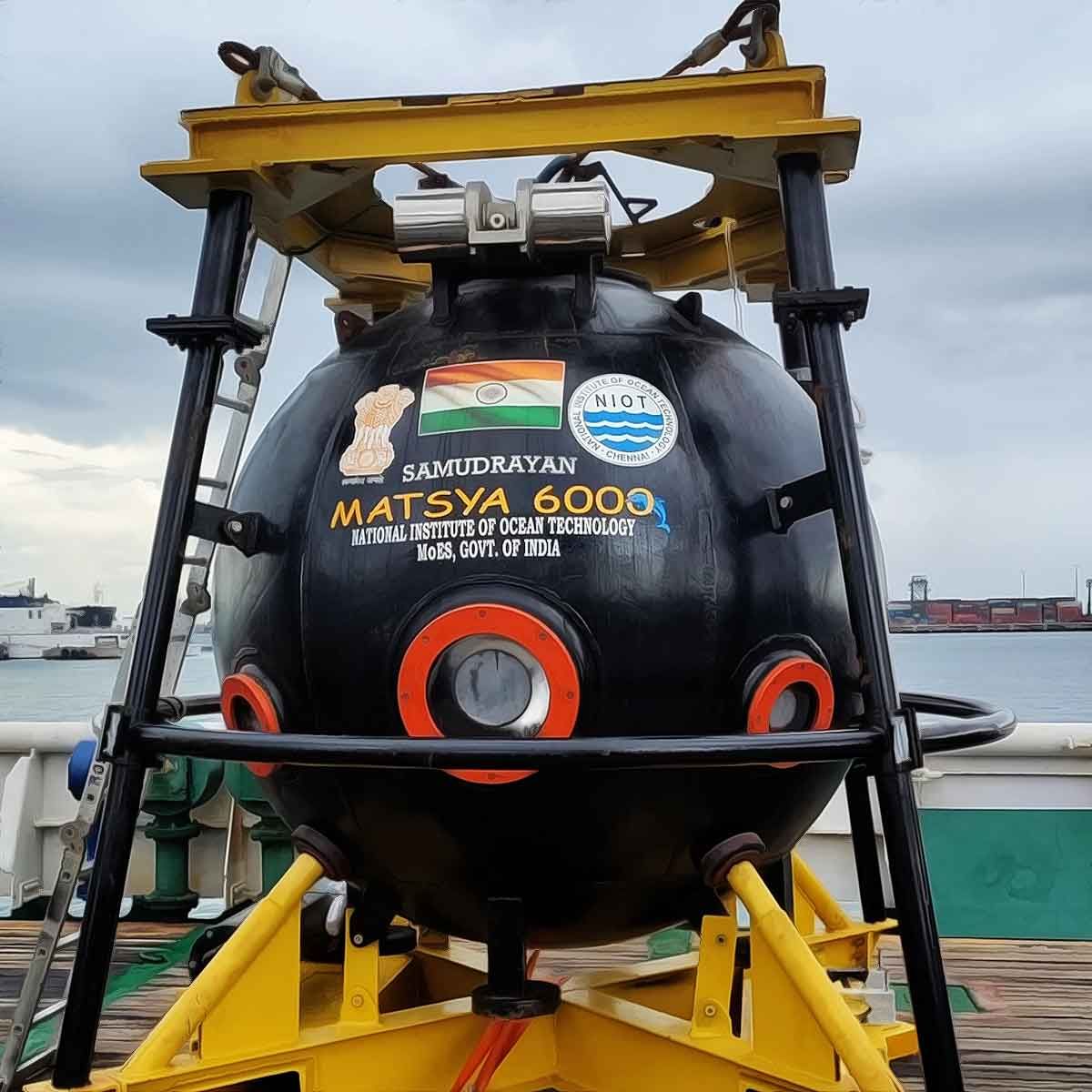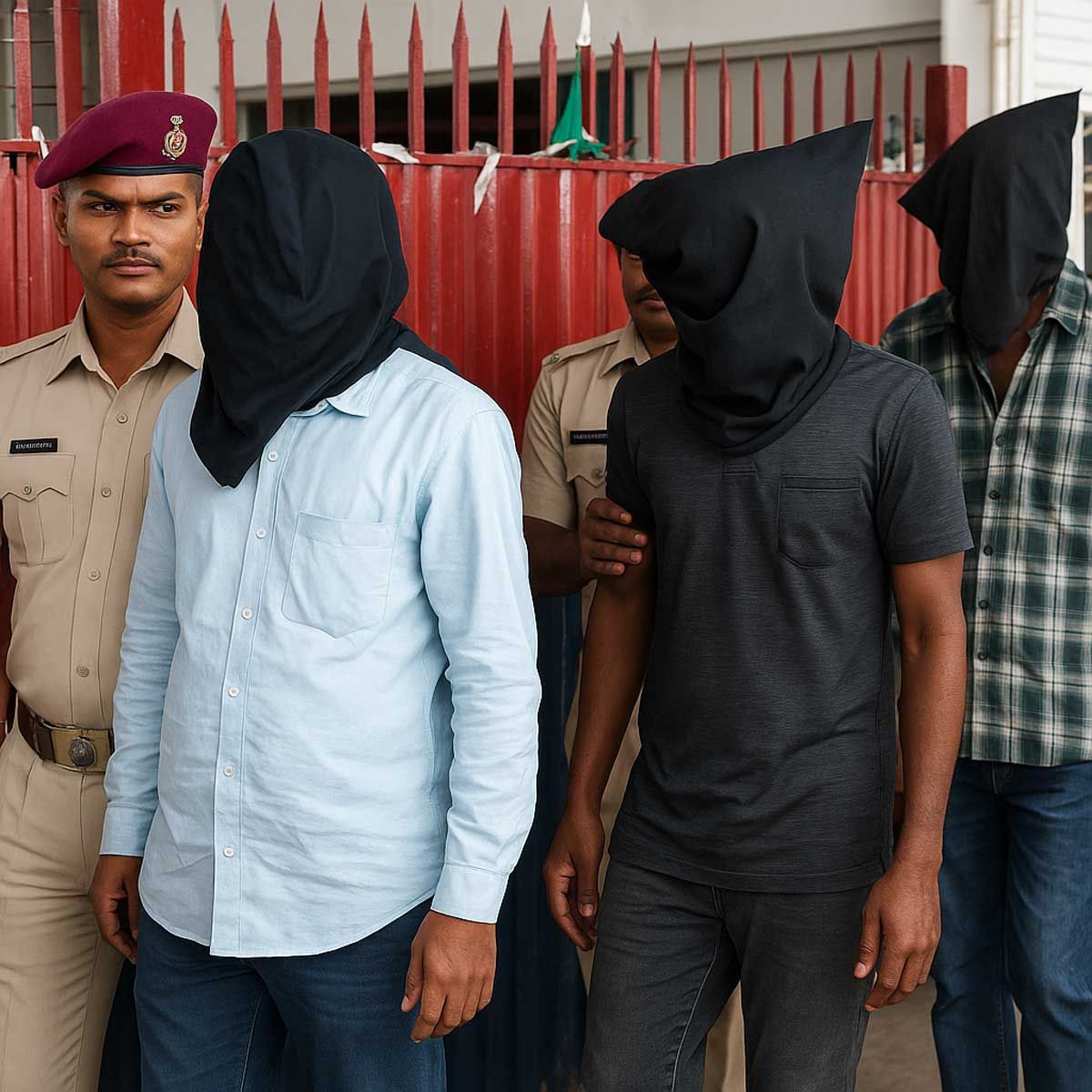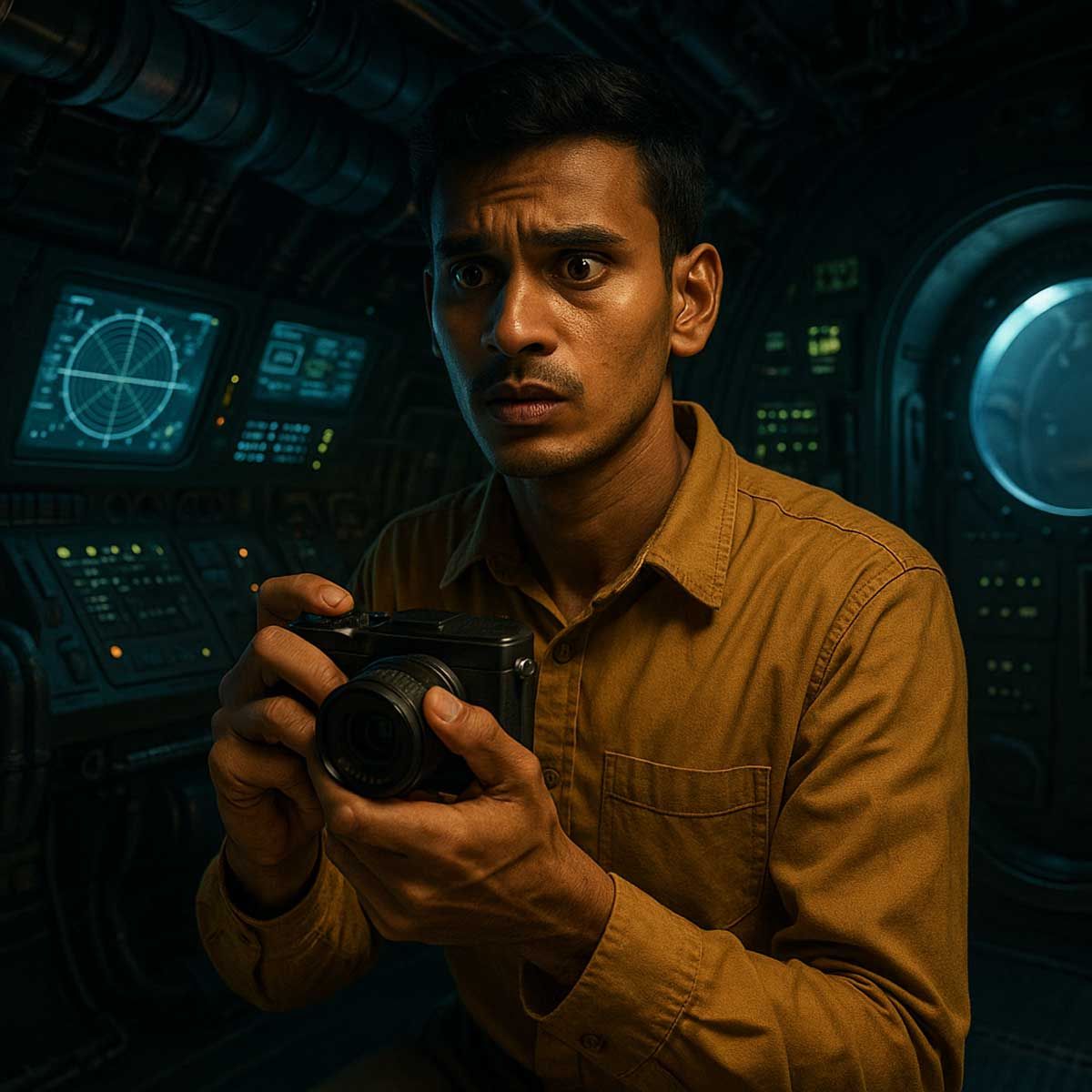More Coverage
Twitter Coverage
Satyaagrah
Written on
Satyaagrah
Written on
Satyaagrah
Written on
Satyaagrah
Written on
Satyaagrah
Written on
JOIN SATYAAGRAH SOCIAL MEDIA
"There is no law except the law that there is no law": Samudrayaan with Matsya 6000 is set to unlock the ocean's enigmatic heart, heralding a new era in harnessing marine resources for a sustainable future symbolizing a big leap in deep-sea exploration

Enthusiasm and national pride are stirring as the National Institute of Ocean Technology (NIOT), situated in India, embarks on a remarkable quest to uncover the mysteries of the ocean depths. This project is referred to as 'Samudrayaan,' symbolizing 'Mission to the Ocean.' The thrilling journey is poised to make history by transporting three brave explorers to an extraordinary depth of 6000 metres under the sea. This venture into the abyss will be conducted in an Indian-made submersible craft named 'Matsya 6000.'
|
Initial tests for this groundbreaking mission are scheduled for 2024. These trials will be conducted at a relatively shallow depth of 500 metres before the craft and its crew are propelled to the extreme depths of 6,000 metres in subsequent stages. The project's importance cannot be overstated as it propels India into a prestigious league of nations. Until now, only five countries have been able to master the feat of deep sea exploration with manned submersible vehicles.
The awe-inspiring 'Matsya 6000' is no ordinary vehicle. Designed specifically for deep-sea exploration, it will enable the crew to delve into the ocean's bountiful mineral resources. The treasure trove awaiting them includes rich deposits of nickel, manganese, cobalt, and various other rare earth elements - resources that could fuel India's growth in various industries.
The critical importance of the mission is stressed by Dr. Tata Sudhakar, the head of the Ocean Electronics Group at NIOT. According to him, safety is paramount when human lives are involved in any operation. The design of the vehicle prioritizes endurance, with a planned operational period of 12 hours. This necessitates factoring in issues like oxygen supply, carbon dioxide release, low temperatures at deep basins, strong deep ocean currents, and humidity. Moreover, a backup system needs to be meticulously in place, acting as a lifeline in case of emergencies.
Dr. Sudhakar elaborates that the basic engineering design for this revolutionary submersible has been completed. A critical part of the project, the life support system, was recently put to the test in a controlled environment at their laboratory tank. He envisages that the 'Matsya 6000' operations would be showcased at a depth of 500 metres in the following year. The mission is then projected to be advanced to the ambitious 6,000-metre depth in the future stages.
This ambitious mission has gained the support and backing of various government agencies and institutions. The Indian Navy, which possesses several deep-diving vehicles, has been a significant ally. This collaboration ensures the necessary expertise from someone with submarine experience to pilot the mission.
|
Dr. Sudhakar emphasizes that this mission will enhance India's stature on the global stage of research and technology. Moreover, it will provide direct benefits in the form of deep-sea exploration. According to experts, underwater vehicles are crucial for various subsea activities, including high-resolution bathymetry, biodiversity assessment, geo-scientific observation, search activities, salvage operation, and engineering support.
The superiority of manned submersibles over unmanned ones is clear. Despite the latter's improved maneuvering and excellent vision systems that replicate direct observation, a manned submersible provides researchers with the invaluable experience of a direct physical presence, along with superior intervention capabilities.
As the technology progresses, remarkable feats have been achieved, with the Chinese-developed Fendouzhe manned submersible reaching an astounding depth of approximately 11,000 metres in 2020. The Samudrayaan mission hopes to follow in these footsteps, setting a new milestone in underwater exploration.
In a nutshell, the Samudrayaan Mission, part of India's Rs 4,077 crore Deep Ocean Mission, aims to augment India's Blue Economy. It seeks to unlock the enigmatic heart of the ocean, exploring and exploiting resources sustainably. The endeavour is fully endorsed by the Government of India and the Ministry of Earth Sciences, placing India in an elite group of countries such as the USA, Russia, Japan, France, and China, which possess the niche technology and vehicles required for subsea activities.
The mission is a bold step forward, resembling ISRO's space exploration initiatives started around 35 years ago. The proposed budget for the project is Rs 4,077 crore for a duration of 5 years, with the first phase's estimated cost of Rs 2,823.4 crore spanning from 2021 to 2024. The project was initially launched in October 2021 and now holds immense national significance as it progresses.
|
Delving into the Core Components of India's Deep Sea Mission
Let's break down the Deep Sea Mission into easily comprehensible parts. The mission is an ambitious one and consists of six crucial components that make it an exciting endeavour.
The First Step: Building a Manned Submersible | A journey of a thousand miles begins with a single step, and in this case, it starts with building a manned submersible. Named MATSYA 6000, this submersible is an indigenous development designed to transport three individuals to the astonishing depth of 6,000 metres into the ocean. Endowed with a set of scientific tools and sensors, this submersible will become a beacon for deep sea exploration. MATSYA 6000 is built to last for 12 hours under operational conditions, and in case of an emergency, it can sustain for up to 96 hours.
This submersible allows scientists to directly interact and observe the mysterious, unexplored depths of the sea. The government has highlighted that this state-of-the-art technology will facilitate the exploration of non-living resources found deep in the ocean, such as polymetallic manganese nodules, hydro-thermal sulfides, gas hydrates, and cobalt crusts, located between 1,000 and 5,500 meters below the ocean surface.
Extracting Polymetallic Nodules | Another key component of the mission is the creation of an integrated mining system designed specifically to mine polymetallic nodules from the central Indian Ocean at depths of up to 6,000 metres. These nodules, also known as manganese nodules, are porous and resemble potatoes in shape. They blanket the sea floor of the world's oceans and, in addition to manganese and iron, contain copper, nickel, cobalt, lead, and more, making them economically and strategically significant.
Through the study and exploration of these minerals, we pave the way towards their commercial exploitation. Once the International Seabed Authority, a UN organization, develops a commercial exploitation code, it will become possible to use these resources on a large scale. This component of the mission aligns with the Blue Economy initiative, which focuses on exploring and harnessing deep sea minerals and energy.
|
The Significance of Polymetallic Nodules for India | The Central Indian Ocean Basin (CIOB) has granted India a site of 75,000 square kilometres for the exploitation of polymetallic nodules (PMN). This is important because, according to the Ministry of Earth Sciences, 10% recovery of this vast reserve can meet India's energy requirements for the next century.
The seabed of the Central Indian Ocean holds an estimated 380 million metric tonnes of polymetallic nodules. These resources remain largely unexplored and unused, even though India's Exclusive Economic Zone spans over 2.2 million square kilometres.
Examining Essential Climate Variables | The second part of the project is concerned with the development of a series of observations and models that will aid in understanding and predicting essential climate variables. These Ocean Climate Change Advisory Services are aimed at supporting the coastal tourism sector, another crucial area of the Blue Economy initiative.
Unraveling Deep-Sea Biodiversity | The third component of the Samudrayaan project is about creating technological innovations to explore and conserve deep-sea biodiversity. A primary focus will be studies on the sustainable utilization of deep-sea bio-resources. Following this, the fourth component involves exploring multi-metal hydrothermal sulphides mineralisation along the Indian Ocean mid-oceanic ridges. The fifth component is concerned with the development of an offshore Ocean Thermal Energy Conversion (OTEC) powered desalination plant, working in tandem with tidal energy. Lastly, an advanced Marine Station for Ocean Biology will be established under this project.
The Relevance of the Project for India | India, with a coastline spanning 7,517 km and home to nine coastal states and 1,382 islands, is uniquely positioned to benefit from this mission. The mission will also boost the Central government's vision of 'New India', highlighting the Blue Economy as one of the ten key aspects of growth. The oceans that border India on three sides and the coastal regions that house 30% of the nation's population play a pivotal role in the country's economy.
Participants in Samudrayaan | Prominent organizations such as the Indian Space Research Organization (ISRO), IITM, and Defence Research and Development Organisation (DRDO) will actively participate in this mission.
Samudrayaan Faces Challenges
The ambitious plan to send the Samudrayaan 6,000 metres deep into the sea might be delayed due to difficulties in procuring a titanium sphere capable of withstanding the intense pressure at those depths. A steel sphere can only withstand pressure up to a depth of 500 metres, after which it will crumple, making titanium the preferred material.
The technology required to build the sphere is exclusive, and no country is currently willing to share it. The conflict in Ukraine has further exacerbated the situation, affecting the timelines for the human spaceflight, pushing it to the end of 2024. Despite these challenges, the Indian Space Research Organisation (ISRO) plans to carry out an uncrewed mission this year to test and validate technologies for the Gaganyaan mission.
 Support Us
Support Us
Satyagraha was born from the heart of our land, with an undying aim to unveil the true essence of Bharat. It seeks to illuminate the hidden tales of our valiant freedom fighters and the rich chronicles that haven't yet sung their complete melody in the mainstream.
While platforms like NDTV and 'The Wire' effortlessly garner funds under the banner of safeguarding democracy, we at Satyagraha walk a different path. Our strength and resonance come from you. In this journey to weave a stronger Bharat, every little contribution amplifies our voice. Let's come together, contribute as you can, and champion the true spirit of our nation.
 |  |  |
| ICICI Bank of Satyaagrah | Razorpay Bank of Satyaagrah | PayPal Bank of Satyaagrah - For International Payments |
If all above doesn't work, then try the LINK below:
Please share the article on other platforms
DISCLAIMER: The author is solely responsible for the views expressed in this article. The author carries the responsibility for citing and/or licensing of images utilized within the text. The website also frequently uses non-commercial images for representational purposes only in line with the article. We are not responsible for the authenticity of such images. If some images have a copyright issue, we request the person/entity to contact us at This email address is being protected from spambots. You need JavaScript enabled to view it. and we will take the necessary actions to resolve the issue.
Related Articles
- ISRO successfully tested the Gaganyaan Service Module Propulsion System (SMPS) on July 19, 2023 at ISRO Propulsion Complex (IPRC) , Mahendragiri
- "Historic launch of Chandrayaan-3": A lunar mission set to make India the fourth nation to land on the moon, encompassing technological marvel, scientific discovery, and national pride, carving out India's place in the annals of space exploration
- "And the winds and the waves are always on the side of the ablest navigators": ISRO successfully launched GSLV-F12/NVS-01 Mission from SDSC-SHAR, Sriharikota, NVS-01 first of the India's second-generation NavIC satellites that accompany enhanced features
- "Ability is Prabhu-given, prowess is earned": New Generation Ballistic Missile Agni Prime successfully flight tested by DRDO on 7th June from Dr APJ Abdul Kalam Island off the coast of Odisha, all the objectives of flight test successfully demonstrated
- "Neglect will drive a noble mind to depart for another land": Brilliant mind - Dr Subhash Mukhopadhyay who created India's first and world's second test tube baby 'Durga' in 1978 with the help of some general equipment and refrigerator was punished for it
- Chandra - NASA’s advanced X-Ray Observatory is named after a brilliant Indian scientist & Nobel Prize-winner Subrahmanyan Chandrasekhar, a Flagship-class space telescope is an Earth satellite in a 64-hour orbit, notably its mission is ongoing as of 2023
- “Is artificial intelligence less than our intelligence?”: In a magnificent leap forward, behold the unveiling of India's first autonomous wonder vehicle amidst the remarkable symphony of innovation, the zPod, by the Bengaluru-based startup Minus Zero
- "Stars align when nations dream together": Beyond defense & trade, Armenia's ambition to explore space with India marks a profound alliance, transcending terrestrial boundaries, this partnership is a beacon of unity, collaboration and a harmonious future
- "Trapping a Scientist": A Kerala cop maliciously framed ISRO scientist Nambi Narayanan in an espionage case after a Maldivian woman rejected his advances, leading to intense surveillance of innocents, and a Supreme Court-mandated Rs 50 lakh compensation
- "The good thing about science is that it's true whether or not you believe in it": Study conducted by Stanford University & Elsevier enlisted Acharya Balkrishna among top 2% of world scientists, PRI relentlessly engaged in making Ayurveda a modern trend
- The legend and a genius that was Jagadish Chandra Bose: Champion of East and West Who Almost Invented the Radio
- India's audacious tryst with the cosmos continues as Chandrayaan-3 flawlessly kisses the Moon's South Pole, a precise Nataraja dance of science, ambition, and national pride, this milestone heralds a new dawn in lunar exploration, Bravo ISRO 🌒🚀
- "Innovation is the calling card of the future": Jaldost, a revolutionary airboat by Bengaluru's National Aerospace Laboratories, powers through aquatic weeds, carving the path towards preserving cleaner water bodies, a testament to indigenous innovation
- Nationalist Congress Party MP Supriya Sule makes false statements about vaccine manufacturing and ridicules Defence Research and Development Organization in Parliament: Details
- "In self-reliance, there is freedom and dignity": In just 18 months, India has embarked on the domestic production of 38 APIs, marking a massive stride towards pharmaceutical self-reliance. It's more than progress; it's a testament to our national resolve




























